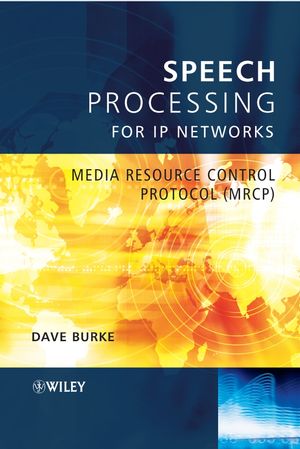Speech Processing for IP Networks: Media Resource Control Protocol (MRCP)ISBN: 978-0-470-02834-6
Hardcover
368 pages
April 2007
 |
||||||
PART I. BACKGROUND.
1. Introduction.
1.1 Introduction to Speech Applications.
1.2 The MRCP Value Proposition.
1.3 History of MRCP Standardisation.
1.3.1 Internet Engineering Task Force.
1.3.2 World Wide Web Consortium.
1.3.3 MRCP: From Humble Beginnings Toward IETF Standard.
1.4 Summary.
2. Basic Principles of Speech Processing.
2.1 Human Speech Production.
2.1.1 Speech Sounds: Phonemics and Phonetics.
2.2 Speech Recognition.
2.2.1 Endpoint Detection.
2.2.2 Mel-Cepstrum.
2.2.3 Hidden Markov Models.
2.2.4 Language Modelling.
2.3 Speaker Verification and Identification.
2.3.1 Feature Extraction.
2.3.2 Statistical Modelling.
2.4 Speech Synthesis.
2.4.1 Front-end Processing.
2.4.2 Back-end Synthesis.
2.5 Summary.
3. Overview of MRCP.
3.1 Architecture.
3.2 Media Resource Types.
3.3 Network Scenarios.
3.3.1 VoiceXML IVR Service Node.
3.3.2 IP PBX with Voicemail.
3.3.3 Advanced Media Gateway.
3.4 Protocol Operation.
3.4.1 Establishing Communication Channels.
3.4.2 Controlling a Media Resource.
3.4.3 Walkthrough Examples.
3.5 Security.
3.6 Summary.
PART II. MEDIA AND CONTROL SESSIONS.
4. Session Initiation Protocol.
4.1 Introduction.
4.2 Walkthrough Example.
4.3 SIP URIs.
4.4 Transport.
4.5 Media Negotiation.
4.5.1 Session Description Protocol.
4.5.2 Offer/Answer Model.
4.6 SIP Servers.
4.6.1 Registrars.
4.6.2 Proxy Servers.
4.6.3 Redirect Servers.
4.7 SIP Extensions.
4.7.1 Capability Discovery.
4.8 Security.
4.8.1 Transport and Network Layer Security.
4.8.2 Authentication.
4.8.3 S/MIME.
4.9 Summary.
5. Session Initiation in MRCP.
5.1 Introduction.
5.2 Initiating the Media Session.
5.3 Initiating the Control Session.
5.4 Session Initiation Examples.
5.4.1 Single Media Resource.
5.4.2 Adding and Removing Media Resources.
5.4.3 Distributed Media Source/Sink.
5.5 Locating Media Resource Servers.
5.5.1 Requesting Server Capabilities.
5.5.2 Media Resource Brokers.
5.6 Security.
5.7 Summary.
6. The Media Session.
6.1 Media Encoding.
6.1.1 Pulse Code Modulation (PCM).
6.1.2 Linear Predictive Coding (LPC).
6.2 Media Transport.
6.2.1 Real-Time Protocol (RTP).
6.2.2 DTMF.
6.3 Security.
6.4 Summary.
7. The Control Session.
7.1 Message Structure.
7.1.1 Request Message.
7.1.2 Response Message.
7.1.3 Event Message.
7.1.4 Message Bodies.
7.2 Generic Methods.
7.3 Generic Headers.
7.4 Security.
7.5 Summary.
PART III. DATA REPRESENTATION FORMATS.
8. Speech Synthesis Markup Language (SSML).
8.1 Introduction.
8.2 Document Structure.
8.3 Recorded Audio.
8.4 Pronunciation.
8.4.1 Phonemic/Phonetic Content.
8.4.2 Substitution.
8.4.3 Interpreting Text .
8.5 Prosody.
8.5.1 Prosodic Boundaries.
8.5.2 Emphasis.
8.5.3 Speaking Voice.
8.5.4 Prosodic Control.
8.6 Markers .
8.7 Metadata.
8.8 Summary.
9. Speech Recognition Grammar Specification (SRGS).
9.1 Introduction.
9.2 Document Structure.
9.3 Rules, Tokens, and Sequences.
9.4 Alternatives.
9.5 Rule References.
9.5.1 Special Rules.
9.6 Repeats.
9.7 DTMF Grammars.
9.8 Semantic Interpretation.
9.8.1 Semantic Literals.
9.8.2 Semantic Scripts.
9.9 Summary.
10. Natural Language Semantics Markup Language (NLSML).
10.1 Introduction.
10.2 Document Structure.
10.3 Speech Recognition Results.
10.3.1 Serialising Semantic Interpretation Results.
10.4 Voice Enrollment Results.
10.5 Speaker Verification Results.
10.6 Summary.
11. Pronunciation Lexicon Specification (PLS).
11.1 Introduction.
11.2 Document Structure.
11.3 Lexical Entries.
11.4 Abbreviations and Acronyms.
11.5 Multiple Orthographies.
11.6 Multiple Pronunciations.
11.7 Summary.
PART IV. MEDIA RESOURCES.
12. Speech Synthesiser Resource.
12.1 Overview.
12.2 Methods.
12.2.1 SPEAK.
12.2.2 PAUSE.
12.2.3 RESUME.
12.2.4 STOP.
12.2.5 BARGE-IN-OCCURRED.
12.2.6 CONTROL.
12.2.7 DEFINE-LEXICON.
12.3 Events.
12.3.1 SPEECH-MARKER.
12.3.2 SPEAK-COMPLETE.
12.4 Headers.
12.5 Summary.
13. Speech Recogniser Resource.
13.1 Overview.
13.2 Recognition Methods.
13.2.1 RECOGNIZE.
13.2.2 DEFINE-GRAMMAR.
13.2.3 START-INPUT-TIMERS.
13.2.4 GET-RESULT.
13.2.5 STOP.
13.2.6 INTERPRET.
13.3 Enrollment Methods.
13.3.1 START-PHRASE-ENROLLMENT.
13.3.2 ENROLLMENT-ROLLBACK.
13.3.3 END-PHRASE-ENROLLMENT.
13.3.4 MODIFY-PHRASE.
13.3.5 DELETE-PHRASE.
13.4 Events.
13.4.1 START-OF-INPUT.
13.4.2 RECOGNITION-COMPLETE.
13.4.3 INTERPRETATION-COMPLETE.
13.5 Recognition Headers.
13.6 Enrollment Headers.
13.7 Summary.
14. Recorder Resource.
14.1 Overview.
14.2 Methods.
14.2.1 RECORD.
14.2.2 START-INPUT-TIMERS.
14.2.3 STOP.
14.3 Events.
14.3.1 START-OF-INPUT.
14.3.2 RECORD-COMPLETE.
14.4 Headers.
14.5 Summary.
15. Speaker Verification Resource.
15.1 Overview.
15.2 Methods.
15.2.1 START-SESSION.
15.2.2 END-SESSION.
15.2.3 VERIFY.
15.2.4 VERIFY-FROM-BUFFER.
15.2.5 VERIFY-ROLLBACK.
15.2.6 START-INPUT-TIMERS.
15.2.7 GET-INTERMEDIATE-RESULT.
15.2.8 STOP.
15.2.9 CLEAR-BUFFER.
15.2.10 QUERY-VOICEPRINT.
15.2.11 DELETE-VOICEPRINT.
15.3 Events.
15.3.1 START-OF-INPUT.
15.3.2 VERIFICATION-COMPLETE.
15.4 Headers.
15.5 Summary.
PART V. PROGRAMMING SPEECH APPLICATIONS.
16. Voice eXtensible Markup Language (VoiceXML).
16.1 Introduction.
16.2 Document Structure.
16.2.1 Applications and Dialogs.
16.3 Dialogs.
16.3.1 Forms.
16.3.2 Menus.
16.3.3 Mixed Initiative Dialogs.
16.4 Media Playback.
16.5 Media Recording.
16.6 Speech and DTMF Recognition.
16.6.1 Specifying Grammars.
16.6.2 Grammar Scope and Activation.
16.6.3 Configuring Recognition Settings.
16.6.4 Processing Recognition Results.
16.7 Flow Control.
16.7.1 Executable Content.
16.7.2 Variables, Scopes, and Expressions.
16.7.3 Document and Dialog Transitions .
16.7.4 Event Handling.
16.8 Resource Fetching.
16.9 Call Transfer.
16.10 Summary.
17. VoiceXML and MRCP Interworking.
17.1 Introduction.
17.2 Interworking Fundamentals.
17.2.1 Play Prompts.
17.2.2 Play and Recognise.
17.2.3 Record.
17.3 Application Example.
17.3.1 VoiceXML Scripts.
17.3.2 MRCP Flows.
17.4 Summary.
Appendix A. MRCP Version 1.
A.1 Overview.
A.2 Session Management and Message Transport.
A.3 General Protocol Details.
A.4 Speech Synthesiser Resource.
A.5 Speech Recogniser Resource.
Appendix B. XML Primer.
B.1 Background.
B.2 Basic Concepts.
B.3 Namespaces.
B.4 Document Schemas.
Appendix C. HTTP Primer.
C.1 Background.
C.2 Basic Concepts.
C.2.1 GET Method.
C.2.2 POST Method.
C.3 Caching.
C.4 Cookies.
C.5 Security.
References.
Index.
Acronyms.



